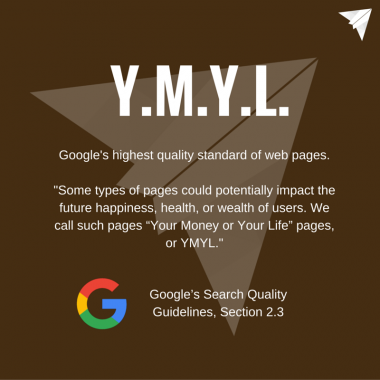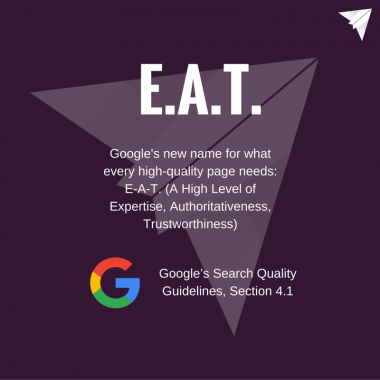Sections
Is SEO Really Dead?
The world of online marketing is richer than ever. Influencer marketing has matured and is delivering results for brands of all sizes. AI and VR are on the horizon. Who knows what’s next?
With so many marketing channels to pursue, many wonder if some of the traditional standbys—like SEO—are still worth investing in.
They ask, “Is SEO really dead in 2019?”
The answer is absolutely not.
Like anything with online marketing, SEO is under constant evolution. What worked five years ago barely moves the needle today. Meanwhile, there are 10 new things you need to pivot toward to maintain your current rankings.
SEO is not dead. Several SEO tactics are, though.
Let’s revamp your SEO strategy for 2019. Below we bust the SEO myths you should leave behind, and shares our best advice for what to focus on instead.
Myth #1: The number one spot is all that matters.
There’s no question about it: The number one spot still carries significant weight. But it’s nowhere near as powerful as it used to be. In just the past two years, the clickthrough rate of spot one has plummeted 37%.
How come?
Well, the Google search results look a lot different than they used to. The days of 10 blue links have been gone for some time, as PPC ads, Google Shopping, YouTube videos, Twitter carousels, Knowledge Graphs, and much, much more take over the first page of search results.
This is actually good news. It means you have more opportunities for visibility on page one.
Pivot your SEO for 2019:
Rather than obsessing over the first spot, optimize for featured snippets instead.
These answer boxes can be taken from any of the results on page one, and reward you with an extra highlighted spot at the top of the search results—in addition to your regular blue link (that’s right, you get two spots in Google!). Bonus: They’re also what voice assistants read off when people use voice search, which will represent 50% of all search by 2020.
Myth #2: Each keyword deserves its own page of content.
A classic old-school SEO tactic was to create a fully-optimized page of content for every single keyword you wanted to rank for. This littered the web with pages like “How to Train for a Marathon,” “How to Practice for a Marathon,” and “Training Steps for a Marathon”—all from the same website.
Because these topics were so hyper-focused, they ranked well for specific long-tail keywords. But Google’s algorithm was a lot more simplistic back then.
Today, those pages seem like serious overkill—to your site visitors and to Google. Google knows how to recognize semantic similarities between content, so any one of those pages should satisfy the searcher’s intent.
Plus, Google much prefers to rank long-form content that comprehensively answers a query and meets either (or both) of their YMYL or EAT guidelines:


Pivot your SEO for 2019:
Instead of over-optimizing your pages for variations of a keyword, invest in well-researched, long-form content that comprehensively answers all of a searcher’s questions related to a particular topic.
For instance, “How to Train for a Marathon in 2019” could include a weekly running plan, dieting tips, different stretching exercises, cross-training suggestions, and popular 2019 marathons—all on one page.
Myth #3: You can get away with a slow website.
Google has always preferred faster pages, but there was a time when it didn’t factor too heavily into their algorithm.
That all changed last year, when Google rolled out their Speed Update. Page speed is now a ranking factor for all websites, both on mobile and desktop.
Why? Google recognizes the importance of speed to users, particularly those using their mobile phones. The longer your site takes to load, the more likely they are to leave—no matter how amazing the content is on your site.

Google equates slower-loading sites with a subpar user experience. When possible, they’ll rank faster-loading pages instead.
Pivot your SEO for 2019:
Focus on improving your site speed.
Aim to get your load time under 3 seconds—or 1 if you can manage it. Top culprits for slow site speed include unoptimized images, too many redirects, render-blocking JavaScript, and not using browser caching or a CDN.
Myth #4: A backlink is a backlink is a backlink.
Google’s long acknowledged that their top three ranking factors are content, links, and RankBrain.
It’s no surprise,then, that there’s a strong correlation between a site’s backlinks and their SEO rankings:

Each backlink serves as a veritable “vote” in favor of your website, but not all links are created equal.
Google doesn’t view a hundred links from low-quality directory sites the same way they view a handful of editorial links from reputable publications. In fact, having too many low-quality links can actually work against you.
Pivot your SEO for 2019:
When it comes to links, go for quality over quantity.
Do NOT work with a link farm, or pay someone on Fiverr to send hundreds of links to your website. Instead, establish relationships with press contacts, journalists, and industry bloggers. Develop original data-backed content that’s newsworthy and naturally earns links all on its own. Partner with local businesses and sponsor local events.
Myth #5: SEO is set it and forget it.
Back in the day, SEO was a lot more plug-and-play.
People wrote over-optimized content for their top keywords, they set up their pages with keyword-rich title tags and meta descriptions, and they bought a few hundred links. Then, they sat back and watched the traffic roll in.
That’s not how SEO works anymore.
The SEO quick hits are still important, of course, including your metadata, schema, and cornerstone content. But to stay competitive, you must continually invest in SEO. You need to be watching your competitors and making sure that your content is always providing more value than theirs and earning links.
Pivot your SEO for 2019:
Make SEO a priority in your marketing.
Dedicate resources to creating content, reviewing your technical SEO, and building authority through backlinks and mentions. Remember, SEO is constantly changing. What’s hot today can be dead in a few years. So, stay on top of the industry trends so that you can strategically plan for the future, rather than play catch-up.
Is Your SEO Dead?
SEO is alive and kicking. Can the same be said for your company’s SEO strategy?
If not, contact Your Marketing People. We’ll work with you to develop a customized SEO strategy that takes your organic traffic to the next level.
Take a look at the SEO results we’ve driven for others here.







